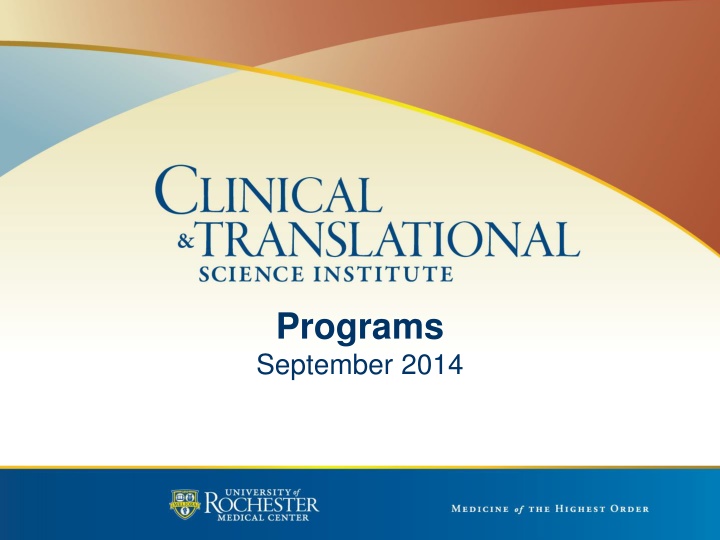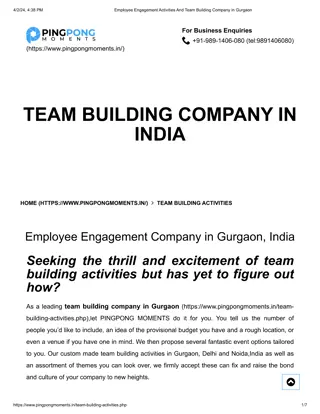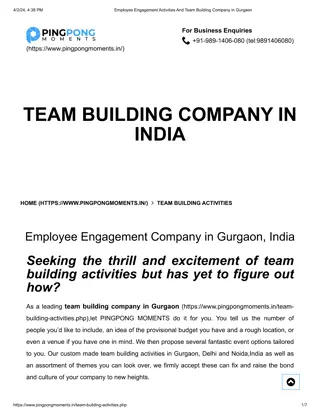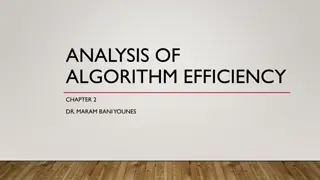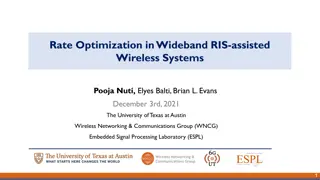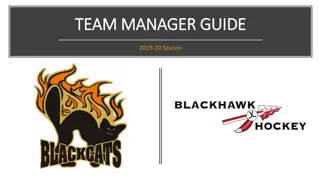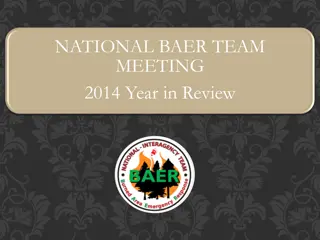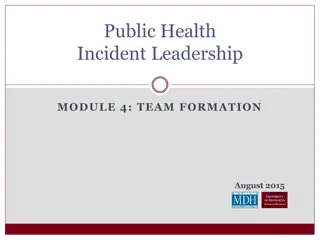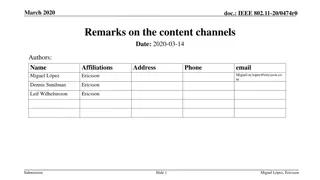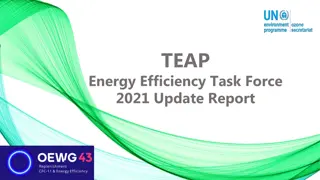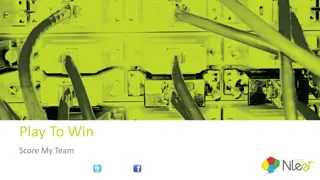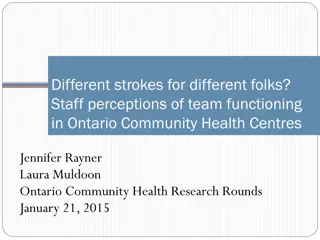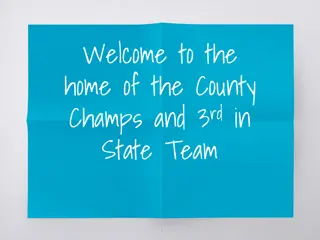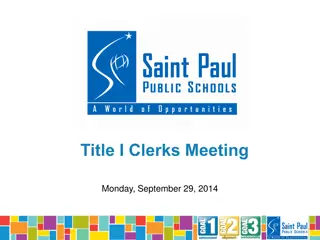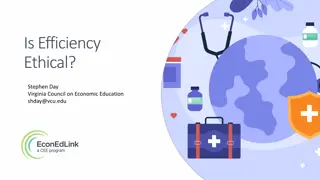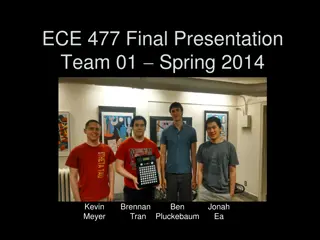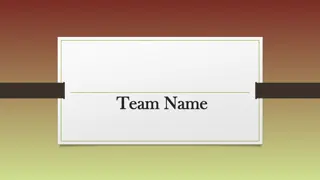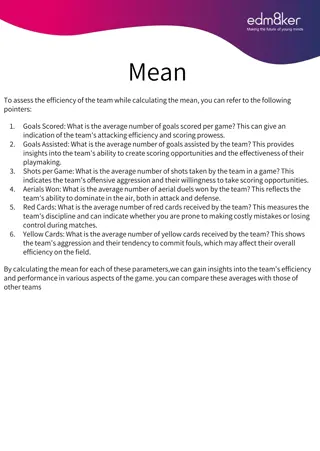Enhancing Research Team Efficiency in September 2014
The Clinical and Translational Science Institute (CTSI) supports research teams to work more effectively. National Center for Advancing Translational Sciences (NCATS) aids in advancing translational sciences by coordinating resources and fostering partnerships. Key initiatives include exploring new therapeutic uses, extracellular RNA communication, and more. The Institute of Medicine (IOM) released a report in June 2013 with recommendations for improving the translational research process. The deconstruction of the CTSA Consortium involved restructuring committees to enhance collaboration and strategic focus.
Uploaded on Apr 04, 2025 | 5 Views
Download Presentation

Please find below an Image/Link to download the presentation.
The content on the website is provided AS IS for your information and personal use only. It may not be sold, licensed, or shared on other websites without obtaining consent from the author.If you encounter any issues during the download, it is possible that the publisher has removed the file from their server.
You are allowed to download the files provided on this website for personal or commercial use, subject to the condition that they are used lawfully. All files are the property of their respective owners.
The content on the website is provided AS IS for your information and personal use only. It may not be sold, licensed, or shared on other websites without obtaining consent from the author.
E N D
Presentation Transcript
Programs September 2014
Connect Learn Get Help The CTSI helps research teams work faster and better.
NCATS Transition 12/23/2011: NCATS formed; NCRR disbanded NCATS Purpose: advance translational sciences by coordinating and developing resources that leverage basic research in support of translational science; and developing partnerships and working cooperatively to foster synergy in ways that do not create duplication, redundancy, and competition with industry activities. Leadership Interim Director Tom Insel (Director of NIMH) Chris Austin named as Director Sep 2012 Divisions of Preclinical Innovation and Clinical Innovation had interim directors, Petra Kaufmann now Clinical Innovation Director NCATS Discovering New Therapeutic Uses for Existing Molecules (New Therapeutic Uses) Extracellular RNA Communication (exRNA) Office of Director Office of Rare Diseases Research (ORDR) Small Business Innovation Research (SBIR) / Small Business Technology Transfer (STTR) Tissue Chip for Drug Screening Assay Development and High Throughput Screening Bridging Interventional Development Gaps (BrIDGs) Chemistry Technology Molecular Libraries Probe Production Center (MLP) NIH Chemical Genomics Center (NCGC) RNA Interference (RNAi) Therapeutics for Rare and Neglected Diseases (TRND) Toxicology in the 21st Century (Tox21) Division of Preclinical Innovation CTSA Program (69% of NCATS budget) Division of Clinical Innovation
IOM Report released 6/25/2013 Suggested vision: A tightly integrated network that works collectively to enhance the transit of therapeutics, diagnostics, and preventive interventions along the development pipeline; disseminate innovative translational research methods and best practices; and provide leadership in informatics standards and policy development to promote shared resources. Recommendations (roughly in order of prominence): NCATS should take a more active leadership role as the principal party in cooperative agreements Greatly streamline committee structure The consortium should work more cohesively together and with external partners toward carefully chosen strategic goals Establish a cross-consortium Innovation Fund Tighten up the evaluation program CTSAs should be allowed more freedom to capitalize on institutional strengths CTSAs should concentrate efforts toward innovative education programs CTSAs should continue to lead efforts in child health research
Deconstruction of CTSA Consortium CTSA Consortium Steering Committee 60 PIs + a dozen NCATS staff + other NIH staff CTSA Consortium Executive Committee 25 PIs + assorted NCATS staff CTSA Consortium Child Health Oversight Committee 5 Strategic Goal Committees 15 key function committees Numerous other task forces and interest groups Before Oct 2014 All former committees and groups were disbanded; coordinating center support was withdrawn A new CTSA Steering Committee was created Chair Elaine Collier (NCATS)- now Petra Kaufmann Vice Chair Nora Disis (PI, U. Washington CTSA) 11 other PIs (including Karl Kieburtz, Rick Barohn) Chris Austin Walter Koroshetz (NINDS) Nov-Dec 2014
NCATS Response to the IOM Report NCATS Advisory Council Working Group on the IOM Report: The CTSA Program May 2014 Workforce Development-Goal: The translational science workforce has the skills and knowledge necessary to advance translation of discoveries. Collaboration/Engagement-Goal: Stakeholders are engaged in collaborations to advance translation. Integration-Goal: Translational science is integrated across its multiple phases and disciplines within complex populations and across the individual lifespan. Methods/Processes-Goal: The scientific study of the process of conducting translational science itself enables significant advances in translation.
Project Development Going forward, the Consortium will operate through time-limited projects, approved by the Steering Committee, with explicit planned outcomes. Initial Project #2: Increasing Accrual to the Nation s Highest Priority Clinical Trials Initial Project #1: Development of a Cross-CTSA IRB Reliance Agreement
Project Development Additional projects now funded via supplemental grants to the leading institutions with subcontracts to the participant CTSA hubs Initial Project #4: Development of Cross- CTSA process for scientific review of materials prior to IRB submission Initial Project #3: Development of Cross- CTSA Clinical research training processes and competencies
Targeted Outcomes-UR CTSI Goals- Clinical and translational research education programs produce skilled multidisciplinary research team members Local, regional and national partnerships support and enhance clinical and translational science Researchers and research teams advance clinical and translational science Clinical and translational research and supporting services are organized within a URMC academic home A diverse spectrum of community members and organizations are engaged in the research process
Six Program Areas and Underpinnings 2014-2015 Budget = $6.1 million Administration, Oversight, Communication 15% Research Education 20% Informatics, IT 13% Funding Programs 15% Clinical Trials 2% Population Health 8% Collaborations and Services 12% Clinical Research Center 15%
Clinical and translational research education programs produce skilled multidisciplinary research team members
KL2 Career Development Program Institutional K-award program 2 years, 75% effort Salary support Some support for other costs Research project costs Travel Competitive application process RFA released in July Applications due ~ October Awards announced ~ March Two or three awards each year
TL1 Predoctoral Training Program Institutional training grant linked to CTSA award Three types of trainees Academic Research Track for medical students (year- out program) PhD students in the Translational Biomedical Sciences Program MD/PhD students with an interest in translational science Each trainee receives a stipend and may receive some support for other costs 10 trainees per year Mentors and trainees supported by CTSI Mentor Development Core
PhD - Translational Biomedical Science One of the first of its kind anywhere Goal: prepare individuals for academic and clinical careers involving the translation of basic biomedical research into clinical strategies to improve health Required and elective coursework in diverse disciplines Epidemiology Biostatistics Microbiology Pharmacology Immunology Neuroscience Biochemistry Physiology And more Skill-building workshops and seminars Research rotations (3 in first year) leading to selection of thesis topic
TL1 Predoctoral Training Program Academic Research Track 1 year of support Medical students apply in December and are selected in February Options Pursue MPH or other research-related masters degree Gain hands-on experience in a lab or research center PhD-TBS students Multi-year support is possible MD/PhD students Multi-year support is possible
Mentor-Protg Curriculum At beginning of program year, prot g s develop a Research Career Development Plan with their mentors Mentoring workshops for mentors and prot g s Mentor group meeting Prot g group meeting Fall a member of the Core meets with each prot g Spring meeting with mentor-prot g dyad
Other Education Programs Research Masters Degrees (provided by Dept. of Public Health Sciences) MS Translational Research MS Clinical Investigation MPH Non-degree programs Academic Core Curriculum - fellows and residents year-long program, weekly meetings Junior Faculty Academic Core Curriculum one-week intensive course Skill-building training Online training in Comparative Effectiveness Research Online training in FDA regulatory fundamentals eRecord for research REDCap i2b2 Annual Scientific Symposium
Local, regional and national partnerships support and enhance clinical and translational science Researchers and research teams advance clinical and translational science
CTSI Research Collaboration & Services Web-hosted information for easy reference http://www.urmc.rochester.edu/ctsi/research-help/ Find a range of resources and services to support each stage of research development and operations Research Help Desk ResearchHelp@urmc.rochester.edu Functions as an information hub, supporting research teams Questions Answered Resources Identified Support for study design Mentors, collaborators and a range of institutional services Shared resources to include in research plan Guidance and assistance to navigate regulations and policies
Voucher Program To request a voucher: http://www.urmc.rochester.edu/ctsi/funding/voucher-system.cfm
Voucher Funding by Beneficiary ($000s) 45 40 Total = $240K since 5/2011 35 30 25 20 15 10 5 0
CTSI Project Funding Programs Pilot Studies Goal: facilitate new research and future project funding 1 year, $50,000 Trainee Pilots Goal: support trainee research 1 year, $25,000 UNYTE Pilots Goal: stimulate new cross-institutional collaborations 1 year, $50,000, two or more UNYTE institutions Novel Biostatistical and Epidemiologic Methods Goal: stimulate new methods to improve validity, accuracy, scope or speed 2 years, $20,000 Incubator Program Goal: accelerate innovative scientific discovery leading to new research programs 2 years, $125,000, two or more linked projects
Pilot Funding by Department ($000s) 1,400 Total = $5.3 million since 2007 1,200 1,000 800 600 400 200 -
Clinical and translational research and supporting services are organized within a URMC academic home
Clinical Research Center The CRC provides support for patient-oriented research: Welcoming In- and outpatient facilities located within the Medical Center (G-5035) and in the Saunders Research Building (1.302) Experienced assistance in Research Nursing, Bionutrition, and Clinical Research Coordination The Center accommodates pediatric to adult research subjects. Access to the Center requires a short application and IRB approval. Modest fees are charged for services.
Expanding the reach and efficiency of clinical trials through technology 21st century technology and methodology should expand the availability of clinical research Clinical trials of new interventions (drugs, devices) will likely benefit the most from these new methods Using remote access (things like Skype) will permit research participants to be seen at home Using remote data sensing (like via smart phones) will simplify getting information Better planning of studies will allow them to be smaller and more efficient
A diverse spectrum of community members and organizations are engaged in the research process
Improving the health of our community(s) Healthcare delivery will change, driven by ACA and financial forces URMC is committed to its Community mission Health should improve as healthcare changes We need to measure what is of most importance to the health of the community and target change in healthcare to the community needs The CTSI wants to be sure that the community s needs for healthcare change, and measuring the impacts on community health are a URMC priority We need to organize how that input is structured so that it is consistently heard and acted upon
National CTSA Directions Revamped NCATS organization- P Kaufmann National Steering Committee setting priorities Site supplements to lead national joint efforts Future areas of focus uncertain still- recent RFA has substantial changes especially for CRC like structures and pilot funding Team science essential
For more information http://us6.campaign- archive1.com/home/?u=85ca914d3653b31ff7ca776b9 &id=65bec3c724 www.urmc.rochester.edu/ctsi Web http://factoryjoe.com/projects/wordpress-icon/files/wordpress-icon-512.png http://urctsi.wordpress.com/ http://cleansocialicons.com/wp-content/uploads/2012/10/transparent-Linkedin-logo-icon.png http://www.linkedin.com/groups/University-Rochester-CTSI- 4334207?trk=myg_ugrp_ovr https://encrypted-tbn3.gstatic.com/images?q=tbn:ANd9GcQ_ejKRlqPcoDvSOdUyhYp63Xd098WyMgeYfXfPwiGpbzXz_-M9MPDsIu67 http://www.youtube.com/user/URCTSI/featured http://ss.utpb.edu/media/images/student-life/twitter_icon.png https://twitter.com/#!/ur_ctsi https://encrypted-tbn2.gstatic.com/images?q=tbn:ANd9GcTlbgKfnFiAOghZe2KqMOQQByqi7K66NfVxr_42l2j34eGZFwnEqQ http://www.flickr.com/people/urctsi
